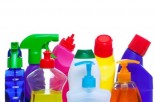But the real criminal threats are the chemicals surrounding your home and environment.
A group of chemicals called phthalates is one such enemy.
Phthalates are used to make plastic more flexible and resilient, but that's not the only place they're found. This chemical is also used in kids' toys as well as home goods, such as shower curtains, vinyl flooring, shampoo, nail polish, hairspray, and wood finishers.
In the personal products, such as shampoo and hairspray, as well as in synthetic air fresheners, phthalates are used to make the scent linger longer.
There are dozens of different types of phthalates, so you need to be a bit of a detective when reading labels on the products you buy. For example, there's one version called dibutyl phthalate, but on product labels it's simply listed as DBP.
Another trick manufacturers enlist to mask their use of phthalates is by using the word "fragrance." This term can hide hundreds of chemicals, because its use is protected.
What are the health risks of phthalates?
Like BPA, phthalates act as endocrine disruptors. They can have feminizing properties in humans, including reduced sperm count and structural abnormalities in the reproductive system. The CDC reports that phthalates have even been linked to liver cancer.
Exposure to phthalates can come in many ways, but one thing you might not consider is that phthalates can exist in the dust in your home and cause conditions such as eczema and asthma.
When you're exposed to high concentrations of phthalates, evidence can be found in your urine, blood and even breast milk.
Individuals most affected are children age 6-11 and women.
4 Tips to Avoid Phthalate Exposure:
- Choose healthier personal care items.
- Avoid plastic toys.
- Avoid PVC vinyl flooring and shower curtains.
- Avoid toxic air fresheners.
Listen now as returning guests Ron and Lisa Beres join Lisa to share the dangers of phthalates, as well as simple steps you can take to reduce your exposure.
